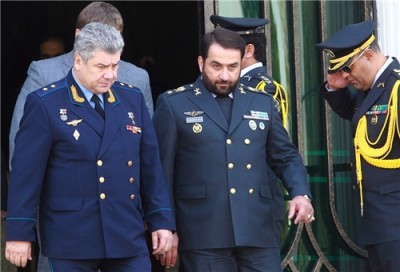Russian Air Force General Visits Iran for talks with Iranian Commanders

During the meeting in Tehran today, Brigadier General Esmayeeli and Lieutenant General Bondarev also discussed exchange of information, air defense techniques, electronic and radar as well as missile systems.
Lieutenant General Bondarev arrived in the Iranian capital at the head of a military delegation on Sunday.
Earlier today, Iranian Air Force Commander Brigadier General Hassan Shah Safi and his Russian counterpart discussed mutual cooperation and regional developments.
The two top air force commanders underlined the need for the further expansion of bilateral and mutual cooperation.
The Iranian and Russian air force commanders also exchanged views over important issues, including missile and defense cooperation.
Lieutenant General Bondarev is also scheduled to meet Commander of the Islamic Revolution Guards Corps (IRGC) Aerospace Force Brigadier General Amir Ali Hajizadeh in Tehran later today.
In 2007, Iran signed a contract worth $800mln to buy five Russian S300 missile defense systems.
But the deal was scrapped in 2010 by the then-Russian President Dmitry Medvedev, who was unilaterally expanding on sanctions against Iran imposed by the UN Security Council.
Iran filed a $4bln lawsuit against Russia in the international arbitration court in Geneva, which is currently pending review.
Moscow has struggled to have the lawsuit dropped, including by offering the Tor anti-aircraft systems as replacement, media reported in August, adding that the offer was rejected by Tehran.
The Antei-2500, however, may be a better solution. The system does not formally fall under the existing sanctions against Iran while still being useful for the Middle-Eastern country.
While the S-300 was developed for the use by missile defense forces, the Antei-2500 was specifically tailored for the needs of ground forces, which could also be an advantage for Iran, known for its large land force.
The S-300 is a series of Russian long range surface-to-air missile systems produced by NPO Almaz, all based on the initial S-300P version. The S-300 system was developed to defend against aircraft and cruise missiles for the Soviet Air Defense Forces. Subsequent variations were developed to intercept ballistic missiles.
The S-300 system was first deployed by the Soviet Union in 1979, designed for the air defense of large industrial and administrative facilities, military bases, and control of airspace against enemy strike aircraft.

